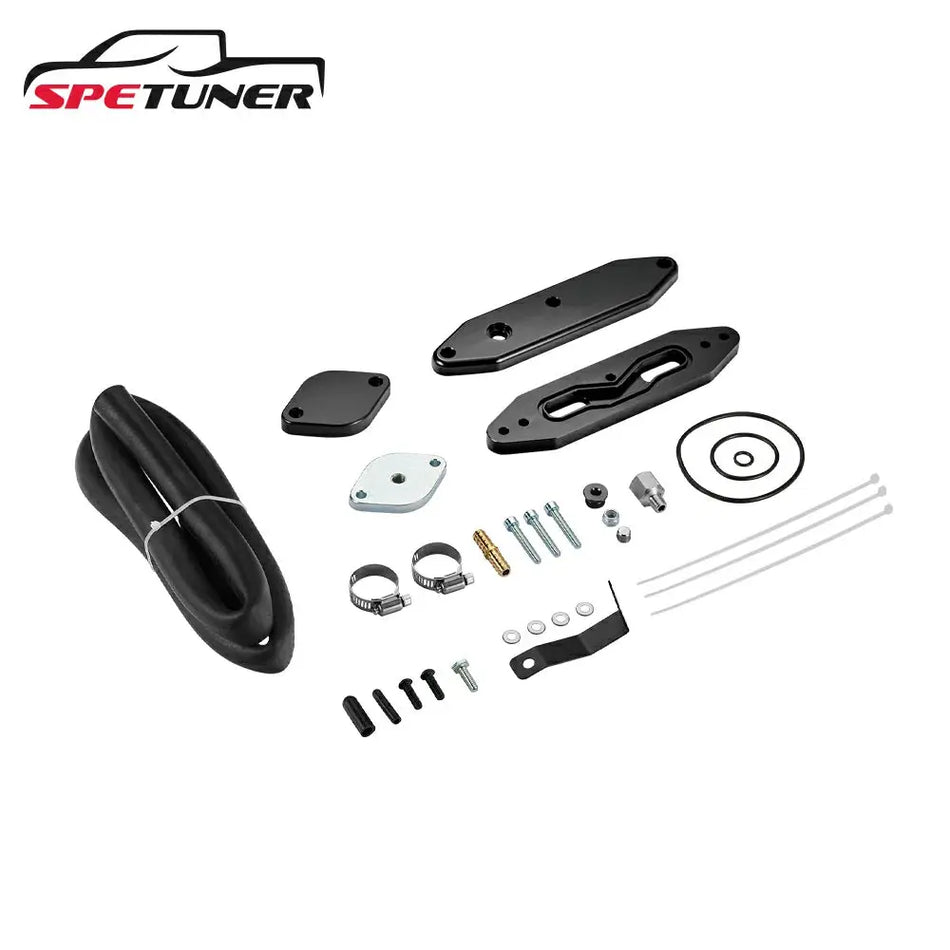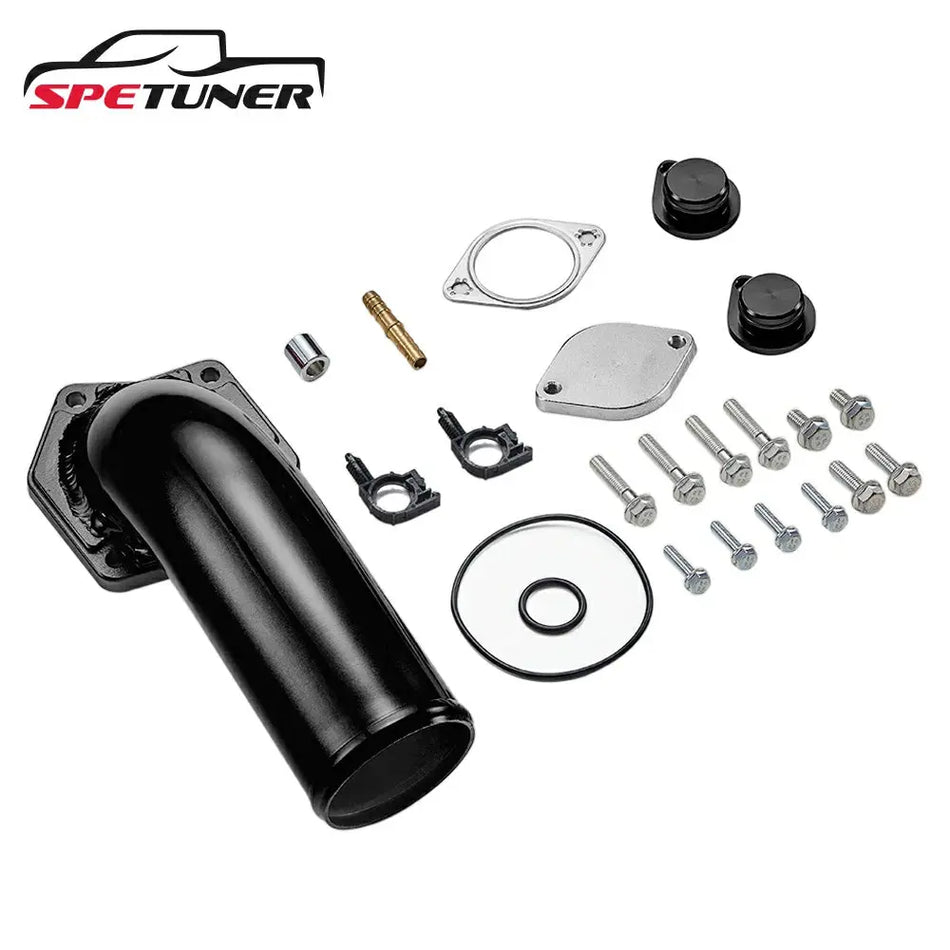Discover how an EGR delete can improve fuel efficiency and horsepower in diesel engines. Learn real-world test results on MPG gains and performance enhancements from EGR removal.
What is the EGR System and How Does It Work?
By design, the EGR system reduces NOx emissions by introducing exhaust gases back into the intake stream. However, these gases displace oxygen in the combustion chamber, meaning there’s less clean air for burning fuel. This results in incomplete combustion, leading to reduced efficiency, more soot buildup, and, in some cases, noticeable drops in fuel economy, especially in towing or high-load conditions.
EGR System's Purpose:
· Emissions Reduction: The primary function of the EGR system is to reduce NOx emissions, which are harmful pollutants.
· Fuel Economy Impact: While the EGR helps with emissions control, it can reduce fuel efficiency by introducing exhaust gases into the combustion process, leading to incomplete combustion.

Common Issues with EGR:
EGR systems can become clogged with soot and carbon buildup, reducing engine performance and efficiency. This can result in:
· Decreased fuel economy.
· Poor engine performance.
· Increased exhaust temperatures.
These issues are even more pronounced in high-mileage trucks or vehicles that do a lot of towing. Users often report symptoms like frequent check engine lights, poor throttle response, excessive DEF usage, and rough idling—symptoms that can all be traced back to a clogged or malfunctioning EGR valve.
The Impact of EGR Deletion on MPG
How EGR Deletion Improves Fuel Economy
When you delete the EGR system, the engine no longer recirculates exhaust gases. This means only clean, fresh air enters the combustion chamber, allowing for more efficient combustion. The engine burns fuel more efficiently with improved combustion, resulting in better fuel economy.
With EGR deleted, the engine receives only clean, oxygen-rich air. This cleaner burn increases combustion efficiency, helping the engine extract more energy from each drop of diesel. Over time, this can mean fewer fuel stops and more miles on every tank, especially under load or highway speeds.
Real-World Data: User Test Results on MPG Improvement
In a practical test conducted by a diesel truck owner, after performing an EGR delete alongside other modifications, the vehicle saw a significant improvement in fuel economy. The test was conducted on a 2016 Ram 2500HD with the following modifications:
· K&N Air Filter
Test Results:
· Before modification: 15-16 MPG.
· After modification: 19-22 MPG.
Additional feedback from diesel forums and truck communities shows similar results across multiple platforms:
| Truck Model | Before MPG | After MPG | Mods |
|---|---|---|---|
| 2015 6.7 Powerstroke | 13.5 MPG | 17.2 MPG | EGR + DPF Delete + EFI Live Tune |
| 2012 LML Duramax | 14.0 MPG | 18.0 MPG | EGR Delete + Cold Air Intake |
| 2008 6.4L Powerstroke | 11.5 MPG | 15.0 MPG | Full Delete Kit + Turbo Upgrade |
While exact results vary by driving style, terrain, and tuning quality, most diesel owners see at least a 15–25% improvement in fuel efficiency after a full delete.
This real-world data showcases a clear MPG improvement, particularly on highways where the truck achieved 25-28 MPG.
For a detailed look at the test, including speed variations, road conditions, and the vehicle's sound changes, refer to the YouTube video, where the user shares the full test results and experience: Watch the video here.
Note: This video is used under fair use for educational and informational purposes, with attribution to the original creator. All content in the video belongs to the creator, and we encourage viewers to watch the full video for an in-depth understanding of the test process and results.
Factors Affecting MPG Post-Modification:
While the EGR delete improved fuel economy in this case, several other factors influence the final result, including:
· Driving habits: Speeding, hard acceleration, and braking can reduce fuel economy.
· Vehicle load: Hauling heavy loads or towing increases fuel consumption.
· Weather conditions: Cold weather can reduce MPG because the engine works harder to warm up.
The Impact of EGR Deletion on Horsepower
Theoretical Explanation: How EGR Deletion Increases Horsepower
The EGR system dilutes the air-fuel mixture by introducing exhaust gases into the combustion chamber. This reduces combustion efficiency, leading to a slight decrease in power output. Deleting the EGR system removes this dilution, allowing for a more efficient burn of fuel and increasing engine power.
Performance Data and Power Gains
While the test data discussed in the previous section didn't directly measure horsepower, improvements in fuel economy often correlate with more efficient combustion and, thus, more power. Many truck owners report a noticeable increase in engine responsiveness and acceleration after performing an EGR delete.
On average, EGR deletes, in combination with other performance upgrades, can result in a 10%- 20% increase in power, depending on the engine and additional modifications, such as diesel delete kits or EFI live tunes.
Though not always captured on a dyno, many drivers notice a more responsive throttle and improved towing power. The cleaner combustion process delivers more consistent torque, especially in the mid-RPM range. When paired with EFI Live tuning or similar systems, EGR delete upgrades can result in 10–20% power increases depending on the engine and setup.

EGR Deletion and Power Delivery:
The engine can produce more power by improving combustion efficiency without increasing fuel consumption. This is especially noticeable when the vehicle is under load, such as during towing or high-speed driving.
Other Impacts and Considerations of EGR Deletion
Noise Changes After EGR Deletion
While many owners report no significant increase in cabin noise, external noise may be noticeably louder, especially at higher speeds. The engine may emit a distinct sound due to changes in the exhaust flow. This is something to keep in mind, especially if you're used to a quieter driving experience.
Impact on the Exhaust System
After EGR deletion, the exhaust temperature may rise, which can stress your exhaust system and other components such as the turbocharger and intercooler. If you are considering an EGR delete, ensuring that your vehicle's exhaust system can handle the increased heat is essential.
Recommended Upgrades:
· High-performance exhaust systems to withstand increased temperatures.
· Turbocharger upgrades to ensure consistent performance.
Maintaining the Turbocharger Post-Deletion
Turbochargers are crucial to a diesel engine's performance. After performing an EGR delete, regular maintenance becomes even more critical. Users have reported needing to replace parts like the turbo actuator after extended use. Ensuring that your turbo system is properly maintained will prevent costly repairs down the line.
Conclusion
Is EGR Deletion Worth It?
Based on the data and user reports, EGR deletion can significantly improve MPG and horsepower, making it a worthwhile modification for many diesel truck owners. However, before proceeding, here are a few key factors to consider:
1. Environmental Regulations: EGR deletes increased emissions, potentially violating local environmental laws. In regions with strict emissions standards, it is crucial to ensure your vehicle can still pass emissions tests.
2. Long-Term Effects: While the EGR delete improves fuel efficiency and power in the short term, the long-term impact on engine components (especially the exhaust system and turbocharger) should be closely monitored.
3. Vehicle Type and Usage: EGR deletion may provide noticeable benefits if you frequently tow or drive at high speeds. However, the benefits may be less significant for everyday city driving.
Maintenance Recommendations
· Regular System Checks: Ensure that your exhaust system, cooling system, and turbocharger are maintained regularly to avoid any issues from higher exhaust temperatures.
· Legal Compliance: Always check your local emission regulations to ensure EGR deletion will not affect your vehicle’s legality.
EGR deletion is an effective way to increase fuel economy and horsepower for diesel truck owners, especially those who drive long distances or frequently haul loads. While it offers significant performance benefits, it is essential to weigh the potential legal and maintenance considerations before deciding to modify your vehicle.
🔧 Ready to take the next step?
SPETUNER offers a complete line of EGR delete kits, tuning solutions, and intake upgrades designed specifically for Powerstroke, Cummins, and Duramax platforms. Whether you're towing heavy or just want to boost efficiency, we have what you need to get the job done right.
Don’t let poor MPG and sluggish power hold you back. See how our EGR delete kits can breathe new life into your diesel truck.
👉 [Browse EGR Delete Kits by Engine Model]
FAQs
Q1: What is an EGR delete, and how does it work?
A1: An EGR (Exhaust Gas Recirculation) delete involves removing the EGR system from a diesel engine. It prevents exhaust gases from being recirculated into the combustion chamber, improving engine efficiency.
Q2: Does an EGR delete really improve MPG in diesel trucks?
A2: Deleting the EGR can improve fuel economy by allowing for more efficient combustion. The engine burns fuel more effectively without recirculating exhaust gases, often leading to MPG improvements.
Q3: How many extra MPG can I realistically expect?
A3: Most diesel truck owners see an MPG increase of 3 to 5 under daily driving, with some reporting gains as high as 7–10 MPG on the highway, especially when combined with tuning and intake upgrades. The most considerable improvements come under heavy towing or long-distance hauling.
Q4: How much more power will I feel after the EGR delete?
A4: While dyno numbers vary, most users report quicker throttle response, stronger acceleration, and better pulling power. With tuning support, gaining 10–20% more power is common, depending on your engine and setup.
Q5: Are there any downsides to doing an EGR delete?
A5: While an EGR delete can improve performance, it may increase emissions and violate local emissions laws. It can also cause higher exhaust temperatures, affecting other engine components over time.
Q6: Can I legally delete my EGR system?
A6: EGR deletion is illegal in some regions with strict emissions regulations, especially in the U.S. and Canada. Always check your local laws before proceeding with this modification to ensure compliance.
Q7: Do I need other modifications to benefit from an EGR delete?
A7: While an EGR delete can improve performance alone, combining it with other modifications, such as a cold air intake, EFI live tuning, or a high-flow exhaust, can further enhance power and fuel efficiency.
Q8: Will my truck sound different after an EGR delete?
A8: Yes, after an EGR delete, you may notice a slight increase in engine noise, especially from the exhaust. However, the sound is typically more noticeable outside the truck, with minimal change inside the cabin.
Q9: How much does an EGR delete kit cost?
A9: Depending on your truck's make and model, an EGR delete kit typically costs between $150 and $500. Professional installation costs can add another $200 to $500.
Q10: How long does it take to install an EGR delete?
A10: Installing an EGR delete typically takes 2-4 hours, depending on the complexity of your vehicle and whether you’re doing it yourself or hiring a professional mechanic.










